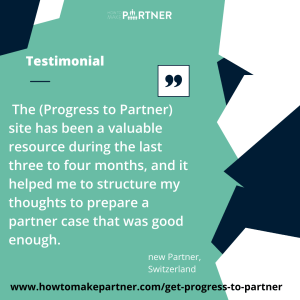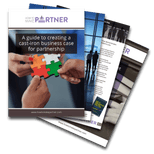How to make sure that you truly ace your presentation of your business case at your partnership panel interview?
This is an extract of an interview that I gave to Errol Williamson a few years ago.
Errol Williamson: First question, your recent blog ‘How to make partner.com’ on your website provided five essential elements that professionals in the service industry would need to take in mind, when putting together their business case when going for partnership status.
Let’s say they’re in a situation where they have to present their business case to the panel and they’ve got 15 minutes to make their presentation, their interview and the partnership recommendation will be based on that presentation so it’s vitally important that they get it right. How would you advise that they should structure the presentation?
Heather Townsend: First and foremost that not every firm will make their future partners do a pitch within a partner panel interview, very often this will be just one part of the process, however it can be a pretty important part.
So, how do they structure the presentation? That’s the key question, it’s probably best to first of all think about what people do wrong.
This is probably the presentation of their life, this is the one that really matters and as a result of that people tend to almost chuck everything in because after all it really matters doesn’t it?
Every single little fact… you can’t do that, actually you can’t do that.
The first thing that I do is I say what is your one sentence promise? What is the one sentence that encapsulates the whole of your business case of why, what is the commercial advantage of promoting you to partner – or really making partner, you don’t get promoted you get admitted to the partnership.
So the first thing you do is you pull out your one sentence sell, so if you only had one sentence to say ‘this is why me.’ that’s that one sentence. You then expand that one sentence into three sentences, the cliché of the elevator pitch you’ve got effectively three sentences, so what are the three core bits of evidence, or fact, or reasons why you should be made up to partner in your business case.
Once you’ve got the one sentence and the three sentence sell the next thing you need to think about is the risk of not promoting you to partner now.
Because after all nobody needs to make you partner, they don’t need to – you’re entering an exclusive club. So you need to answer those three questions, and in essence those form almost the basis of the structure of your presentation, because you start off with the three sentence sell.
You hook them in by the opening; ‘How many of you would like to do this?’ ‘What’s the opportunity here?’ You ask them engaging questions around that three sentence sell which kind of really goes ‘Right! (look them right between the eyes) this is the benefit of making me partner’.
You then take each of those parts of those three sentence sells, normally there’ll be three parts, three compelling arguments, and you develop each of those three arguments.
So maybe there’s an opportunity within the audit market place for mid-market tourism firms or hospitality and leisure firms, that’s where you spell out the opportunity. You do each of those three, now it might be that you’re spelling out the opportunity, it might be you’re showing your track record, it could be anything but it’s the three compelling reasons that kind of go ‘Why me!’. This is the evidence and the qualification.
The next thing is what’s the risk of dragging your heels?
That’s the thing about partnerships is they’re great at dragging their heels, so actually what is the risk of not doing it? What are they going to miss out on, because it’s amazing how many partnerships are more motivated by the thought of something they’re going to miss out on, rather than the pleasure of what they’ll have when you come into the partnership. So if you structure your presentation way you have the four key elements:-
- Your Three sentence sell.
- Develop each of those three parts of that three sentence sell.
So if you think about it you’ve effectively got four slides.
You then do:-
- The risk of not promoting me.
And then the final slide that you need is:-
- The call to action.
It could be as simple as ‘if you would like to get the benefits of x, y, z, then my suggestion is you recommend me for partnership’. It could be as simple as that but you do want to leave them with a compelling statement, it might be a summation of your one-sentence cell, but a real compelling call to action. That effectively is how you structure your presentation.
If you do it this way you’ll avoid death by PowerPoint. One of the big things that you mustn’t do is go ‘Right, how can I get War and Peace onto these slides?’ The whole point about why many firms force you to use a slide deck… and just this weekend I was talking to somebody who was being asked by her big four firm to produce 6 to 10 slides with a headline of her business case.
That’s how you avoid death by PowerPoint. That’s the bit you must include. What can you afford to leave out? Leave out every single reason why you should be partner, they don’t want to know that. Really think about what they want to hear, how they want to hear it and how you’re going to deliver it. So how do you mentally prepare for that presentation, particularly when this is probably the toughest, the biggest presentation you’ll ever give in your career if you’re in a profession like an accountant or a lawyer going for partnership. It is the biggest, so how do you mentally prepare?
Firstly the clue is in the question, you prepare. Far too many people wing it, and don’t spend the time that this deserves. Practice, practice, practice and then practice again.
What I recommend you do is that you have the first three minutes memorised, and you have the last three minutes memorised, and you practice each of those audibly at least 10 to 15 times; the first three minutes, the last three minutes. What that will do is it will help you to get through those initial nerves, you will be absolutely sorted because your brain, the subconscious will do the talking for you regardless of what’s happening to your heartbeat.
So that’s one of the ways of minimising nerves and that’s one of the ways to mentally prepare.
I recommend another way of preparing is to spend time with somebody else. So what do I mean by that? Go through this presentation with your mentor, go through this presentation with your sponsoring partner and get their views on it.
Go through the presentation with your coach. Practice, practice, practice, get feedback, get feedback. If you haven’t literally practiced audibly for 15 times from beginning to end your presentation before you go in there you are not ready. I’m sorry I have to spell it out but so many people take what I would call shortcuts.
The next thing you need to do is you need to make sure you’re in the right state of mind to walk into that room. So go and have a look at the room, if you can do have a look at the room and know what you’re getting into. When you’re in the room visualise yourself delivering it, visualise the partners eyes being engaged, visualise them smiling at you, visualise that pin dropping as they’re hanging on your every word.
Visualise almost them giving you a mental round of applause, get really good thoughts into your head. Get the smell, get the feel, and get as many of your senses when you’re in the room to connect with you delivering that process. Also when you’re in the room have a run through of it again, this is one of the times that actually it’s very tough to be over-rehearsed.
Once you’ve done that you might like to work with a presentation coach, you may like to use things like affirmations, and this can work for some people particularly those that find themselves really struggling to deliver presentations. Affirmations are always personal to use such as ‘I can do whatever I want to do’, ‘I’m confident’, ‘I’m a great presenter’, the best way to use affirmations are you need to say them out loud audibly, at least 5 or 6 times a day.
You need to look yourself in the mirror and say them, and say them with conviction and really connect with your gut as you say them. Then when you’re about to go into it, say that affirmation, you’ll be amazed how much of a difference it makes particularly if you’ve said it with oomph!! A real conviction, put yourself into it. That way that affirmation is going to help your mind to mentally get into the right state of being up for it, but not up for it in a too arrogant way.
So how do you control the nerves in that last hour? Everybody is different, but what you need to do is switch off and what you need to do is relax. Potentially you might want to do some relaxation exercises, some deep breathing where you breathe in for the count of six, you hold for the count of six, and you breath out for the count of six.
That’s actually a really good one that you can do anywhere at any time, and what it does is it just forces you to relax your breathing which helps get rid of the emotion that could be choking you, and it gets your heart-rate down. Do what you normally do to control your nerves, but actually the thing that gives people nerves the most is when they’re under-rehearsed, so the best thing you can do is practice many times before that last hour.
Maybe get a pep-talk from your mentor/your sponsoring partner, get a pep-talk from your external coach, whatever you need to do to feel good in that moment. So something that I do normally in the last hour is I literally write out the key words and phrases, so I’ve got it in my mind as I’m going through.
 Take a step forward to be in control of your own career progression in your firm. Sign up to my weekly tips here and you’ll find out what you need to be working on in your career development (and how to make the time for your career development) to progress your career in your firm.
Take a step forward to be in control of your own career progression in your firm. Sign up to my weekly tips here and you’ll find out what you need to be working on in your career development (and how to make the time for your career development) to progress your career in your firm.
An idea of the size of client portfolio you will need to be a partner in a Big 4 firm
What due diligence should I do on my firm before buying in
6 tried and tested tips to ace your Partner Panel Interview
The definitive guide to building a business case for partnership
See whether you are a good fit for partner in your firm
What’s included in the FREE guide:
 1. Extracts from real and successful business cases for partnership
1. Extracts from real and successful business cases for partnership
2. How to structure your business case for maximum impact
3. What questions your business case needs to answer
Click here for more information about the guide








